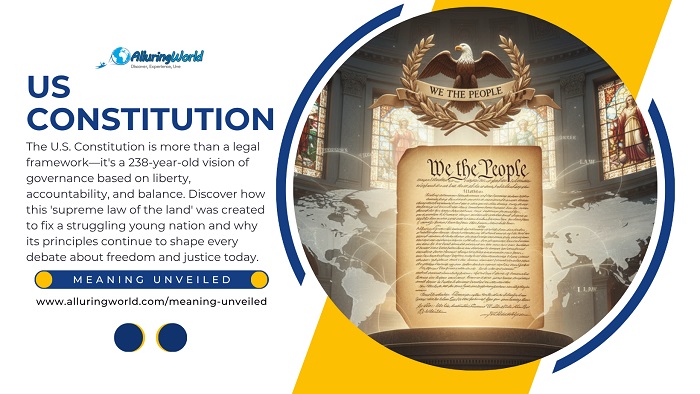Read time ca. 5 minutes
The Constitution of the United States stands as one of the most influential documents in modern world history. Signed on 17 September 1787 by the delegates of the Constitutional Convention in Philadelphia, it established the foundation for the nation’s government, as it set forth the principles that would continue to guide political life more than two centuries later. At its core, the Constitution is more than a legal framework because it is a vision of governance that is based on liberty, accountability, and balance. To understand its meaning is to grasp not only the intentions of the framers but also the enduring values that shape American democracy today.
Origins and Purpose:
As soon as the United States gained its independence from Britain, the young nation was operating with a system that had weaknesses that were revealed shortly. This system was known as the Articles of Confederation, and without a strong central authority, the US states struggled with economic instability, limited unity, and conflicting interests. The Constitutional Convention of 1787 was called to address these problems and to design a new system capable of both preserving individual freedoms and ensuring national cohesion.
The document that emerged was an innovative blend of ideas drawn from Enlightenment thought, classical history, and colonial experience. The end goal was to create a government powerful enough to govern effectively, yet restrained enough to protect the rights of the people.
Structure and Framework:
Composed of a preamble, seven articles, and a series of amendments, the Constitution is fundamental, “the supreme law of the land”. The preamble outlines its purpose: “to form a more perfect Union, establish justice, ensure domestic tranquility, provide for the common defense, promote the general welfare, and secure the blessings of liberty.” These words encapsulate the aspirations of a nation seeking stability after years of revolution.
The articles then detail the architecture of government. The legislative branch, responsible for making laws, was placed in the hands of a Congress divided into two chambers: the House of Representatives and the Senate. The executive branch, led by the president, was tasked with enforcing laws and managing national affairs. The judiciary, anchored by the Supreme Court, was designed to interpret the law and safeguard the Constitution’s principles. This separation of powers was additionally combined with a system of checks and balances so that it would make sure that no single branch could dominate the others.
The Bill of Rights and Amendments
Soon after ratification, the first ten amendments, known as the Bill of Rights, were adopted to guarantee fundamental liberties. These included protections for speech, religion, press, assembly, and petition, as well as safeguards against unfair government intrusion. Throughout time, there were some additional amendments that were included and addressed issues such as the abolition of slavery, voting rights, and equal protection under the law. As the Constitution changed with the years, each of the new amendments shows a moment of evolution, as well as how the Constitution adapts to changing circumstances while preserving its core principles.
Enduring Significance:
The meaning of the Constitution extends beyond its text. It represents the idea that government exists to serve the people, not the other way around. The emphasis that is put on limited power, accountability, and personal freedom reflects a deep commitment to democratic ideals. While the creators could not have foreseen every challenge the nation would face, they still managed to design a system flexible enough to grow with time. Judicial interpretation, legislative action, and public engagement have all ensured that the Constitution remains relevant in a world far different from that of the 18th century.
Contemporary Relevance:
Even today, the Constitution continues to shape debates about justice, equality, and governance. As there are questions about privacy, technology, civil rights, and the role of government, they are interpreted through the Constitution’s lens. US Courts are always relying on its provisions and with it they are resolving disputes, legislators use it as their guiding authority, while citizens invoke it to defend their freedoms. Its endurance speaks to its strength: it is a living document that balances stability with adaptability.
Conclusion:
In conclusion, the United States Constitution is far more than parchment paper with some writing on it. It is the framework of a nation’s political identity and a symbol of enduring ideals. Created in a time of uncertainty, the Constitution still continues to embody a promise of liberty, fairness, and shared responsibility. The meaning behind this important “law above all laws” lies in its words and in the way it inspires participation, protects rights, and upholds the idea that power ultimately rests with the people. In reflecting on its significance, one is reminded that the Constitution is both a product of its time and a guide for the future, offering lessons on governance, resilience, and unity that remain vital today.

